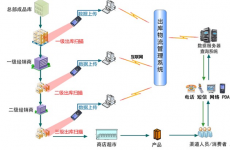
RFID anti-counterfeiting and anti-channeling management system
[ad_1]
System Overview:
With the rapid development of the market economy, the diversification and richness of consumer goods market products such as clothing, leather goods, luggage, etc. have been promoted, and the needs of consumers have been fully satisfied. But at the same time, counterfeit, counterfeit products, and counterfeit products of some well-known domestic and foreign brands have also appeared in large numbers, seriously affecting the interests of consumers and businesses. Many well-known brand companies are constantly looking for new ways to promote and protect their brands and products.
The phenomenon of counterfeit goods and pirate goods is manifested in the consumer goods industries such as alcohol, food, medicine, clothing, leather goods, luggage and bags. Once the product is counterfeited and substandard, it will bring immeasurable losses to personal interests and business development. . The production, circulation, and use of these products require safe and effective safeguards against counterfeiting and counterfeiting.
System goals:
China has always been known as a big country of counterfeit goods. Counterfeit and inferior products not only bring the loss of vital interests to enterprises and consumers, but also seriously affect the country’s economic development and reputation. Now countries and enterprises spend a lot of manpower and financial resources on anti-counterfeiting and anti-counterfeiting every year.
At the same time, the network fleeing goods seriously caused the lack of control of the flow of goods, the channel control became a mere formality, and the agents were polarized, resulting in high risks for the company and the use of preferential policies, which did not bring out the expected benefits. Fleeing products are dumped at low prices online. Such a vicious circle also seriously affects the interests of other agents.
However, most of the products on the domestic market currently use one-dimensional and two-dimensional barcodes for automatic identification and data collection. Its technology does not have uniqueness and exclusivity, and it is easy to copy, so it can not play the role of real anti-counterfeiting and anti-smuggling. At present, the international automatic identification field has gradually emerged a trend of using electronic label technology for anti-counterfeiting and anti-channeling. With the mature development and popularization of RFID technology, its advantages have attracted widespread attention.

System advantages:
It uses radio frequency for non-contact two-way communication to achieve identification and exchange data. The use of radio frequency identification technology for anti-counterfeiting, compared with other anti-counterfeiting technologies such as laser anti-counterfeiting, digital anti-counterfeiting, etc., has the advantage that: the company affixes a unique RFID label on each product, which contains the product name specification information, production information, Serial number, sales information, etc., each tag has a globally unique ID number-UID, and RFID electronic tags become the “identity card” of the product. The electronic tag has a unique code in the world that cannot be modified or imitated; it has no mechanical abrasion and anti-fouling characteristics, making RFID technology the world’s most advanced anti-counterfeiting and anti-channeling technology.
In terms of data security, in addition to the password protection of the electronic tag, the data part can be managed by some algorithms; there is a mutual authentication process between the RFID reader and the tag.
RFID technical characteristics:
◆ The global unique ID anti-counterfeiting chip cannot be modified or counterfeited;
◆ Flexible installation method ensures that the chip cannot be disassembled or transplanted;
◆ Easily realize the whole-process monitoring and tracking of the asset’s physical life cycle;
◆ Through the handheld reader, the authenticity of batches can be verified with manufacturers in any Internet access network;
◆ The chip has a built-in storage space of 96bit or greater, which can write manufacturer customized information and can be encrypted;
◆ Long-distance reading can be achieved through the reader, the fixed reader is 7~12 meters, and the handheld reader is about 2 meters;
◆ It can read more than 100 tags in batch within 1 second, speeding up logistics operation;
◆ RFID collected data can be used for data exchange and docking with the company’s existing application systems.
Function description:
1. Product traceability and identification function RFID tags have a unique code, which is equivalent to issuing an ID card to each product, and because it carries electronic information, its data content can be protected by a password. Its content is not easy to be forged and altered. Compared with other labels, it has more security and anti-counterfeiting performance of the product. And because of its uniqueness, it is difficult to imitate and the cost is high. Therefore, the use of RFID tags can truly help brand owners achieve the purpose of anti-counterfeiting and anti-smuggling.
2. Penetration and non-barrier reading RFID tags can penetrate non-metallic or non-transparent materials such as paper, wood and plastic, so that they can be sewn inside the product to track the flow of the product and prevent malicious damage and disassembly.
3. The function of reading and writing data is through the RFI D tag, without contact, you can directly read or write information to the tag within a certain distance, and the written content can be rewritten (erased) multiple times. Batch operations can be performed when reading and writing, up to 200 pieces per second. Therefore, the cost of use is reduced to a large extent and the efficiency of logistics is improved.
4. Miniaturized and diversified shapes RFID tags are not limited by size and shape in reading, and do not need to match the fixed size and printing quality of paper for reading accuracy. In addition, RFID tags can be more miniaturized and diversified shapes to be applied to different products.
system interface:

[ad_2]






